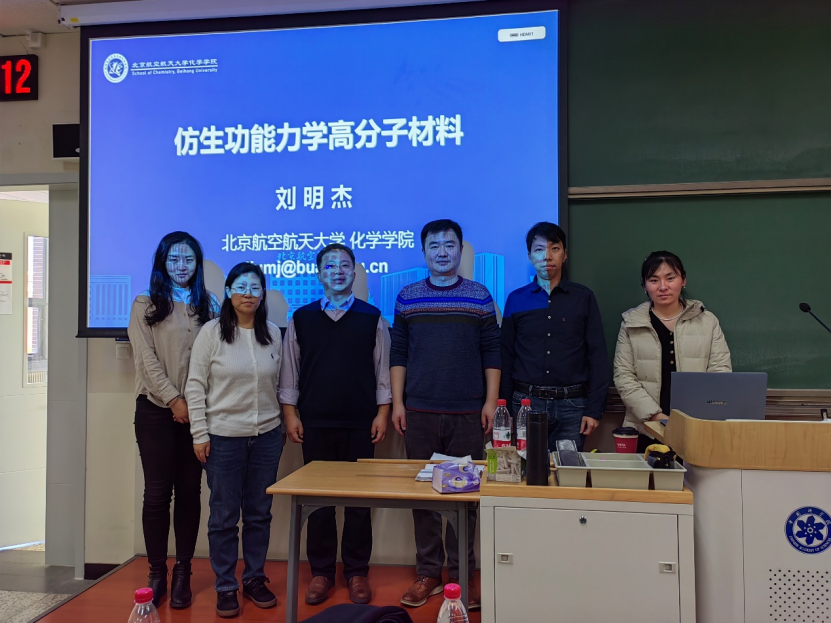-
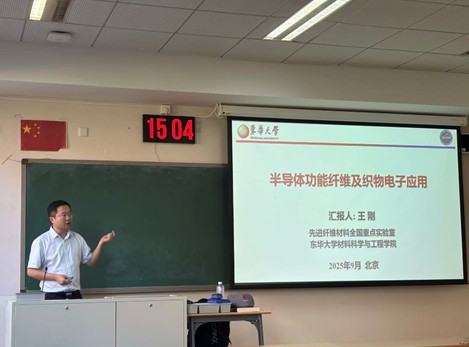 Professor Wang Gang’s Lecture on “Semiconductor Functional Fibers and Fabric Electronic Systems”
Professor Wang Gang’s Lecture on “Semiconductor Functional Fibers and Fabric Electronic Systems”On September 1, 2025, at 3:00 p.m., Professor Wang Gang from the School of Materials Science and Engineering at Donghua University, invited by Professor Huang Hui, delivered a lecture titled “Semiconductor Functional Fibers and Fabric Electronic Systems” at the University of Chinese Academy of Sciences, Yanqi Lake Campus, Room 114 of Academic Building 2.
Professor Wang Gang, Deputy Dean and Researcher at the State Key Laboratory of Advanced Fibrous Materials and the School of Materials Science and Engineering, Donghua University, is the project leader of the National Key R&D Program. He has received the National New Era Youth Pioneer Award, the First Prize for Teaching Achievements from the China National Textile and Apparel Council, the Outstanding Contribution Award for Industry-Academia-Research Cooperation from Glory Group, and the Shanghai Youth May Fourth Medal. He was also selected for the Ministry of Organization’s National Young Thousand Talents Program and the Shanghai Technology Youth 35 Leaders Plan. In the past five years, he has published 15 academic papers in journals such as Nature Materials, PNAS, Chemical Reviews, and Nature Communications, been granted 10 Chinese invention patents, and built the first continuous production line for semiconductor superstructure fibers with a capacity of grams per minute. He serves as Executive Secretary-General of the International Advanced Fibrous Materials Society and Executive Editor of the Q1 journal Advanced Fiber Materials. He has presided over major national projects such as the National Key R&D Program and the National Natural Science Foundation’s Major Research Plans. He also led the establishment of a major university-enterprise joint research platform, the “Starry Sky Laboratory,” whose fabric electronic products have been applied in active health monitoring, energy pipeline networks, and technological Olympic equipment.
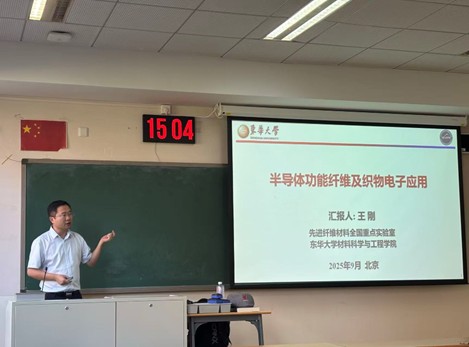
At the beginning of the lecture, Professor Wang emphasized that with the rapid development of semiconductor polymers, fibers and textiles integrated with electronic functions are emerging, showing great potential in brain-machine interfaces, health monitoring, and portable computing. These materials are especially promising for wearable and implantable applications. A key scientific challenge, however, lies in fabricating one-dimensional fibrous semiconductor devices from high-dimensional semiconductors while preserving their inherent properties.

Professor Wang then elaborated on his team’s approaches to overcoming these challenges, which include:
1. Proposing a novel design concept of “microfluidic shear field–induced semiconductor fiber formation,” enabling precise microfluidic control to finely tune composition, interfaces, and orientation during the spinning process.
2. Improving lithography techniques to transfer precise patterns onto fiber surfaces, thereby fabricating high-performance circuits such as fiber-shaped diodes and transistors.
3. Developing semiconductor fiber integration strategies such as “lithography-weaving” and “topological-weaving,” which have been successfully applied in active health systems, West-to-East Gas Transmission pipeline monitoring, and critical equipment for technological Olympics.
Finally, Professor Wang’s presentation sparked deep reflection, lively exchanges, and discussions among the faculty and students in attendance. The participants all agreed that they gained invaluable insights from the lecture.

-
 Dr. Zhu Zonglong's lecture on " Advancing the Frontier of Perovskite Solar Cells: Strategies for Enhanced Stability through Interface Engineering"
Dr. Zhu Zonglong's lecture on " Advancing the Frontier of Perovskite Solar Cells: Strategies for Enhanced Stability through Interface Engineering"At 15:30 p.m. on June 26, 2025, Dr. Zhu Zonglong from the Department of Chemistry at City University of Hong Kong was invited by Professor Huang Hui to give a lecture on the theme of " Advancing the Frontier of Perovskite Solar Cells: Strategies for Enhanced Stability through Interface Engineering", which was held in room 115 of the Teaching Building 1.
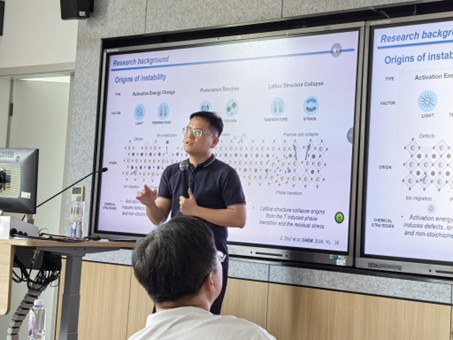
Dr. Zonglong Zhu is an associate professor at City University of Hong Kong. 2006-2010 B.S., Department of Chemistry, Nanjing University. 2010-2015 Ph.D., Department of Chemistry, Hong Kong University of Science and Technology. 2015-2017 Postdoctoral Researcher, Department of Materials Science and Engineering, University of Washington, USA. 2017 Visiting Scholar, Hong Kong University of Science and Technology. 2018-present Associate Professor, City University of Hong Kong. Since joining the university as an assistant professor in 2018, he has authored numerous papers as the corresponding author in renowned journals such as Science, Nat. Nanotech., Nat. Commun., Chem. Soc. Rev., Acc. Chem. Res., J. Am. Chem. Soc., Adv. Mater., Angew. Chem. Int. Ed., and others. Dr. Zhu has published over 110 SCI papers, with over 13,000 citations and an impressive H-factor of 50. Dr. Zhu's contributions to the field have earned him numerous accolades. He has been recognized as one of the top 2% of scientists with the most citations in the world in 2021, Emerging Investigator of Nanoscale in 2022, Emerging Investigator of J. Mater. Chem. A in 2021, and Highly Cited Researcher in Cross-Field in 2022. In addition, he has received several awards, including the President's award and Yong research award from the College of Science at CityU in 2022.
As the quest for sustainable solar energy solutions advances, organic-inorganic hybrid perovskite solar cells (PSCs) have captured significant attention due to their high power conversion efficiencies, challenging traditional silicon-based photovoltaics. Despite remarkable progress, the Achilles' heel of PSCs remains their limited long-term stability, a critical barrier to commercial viability. To address this, Prof. Zhu made it clear that understanding the mechanisms of instability and exploring innovative solutions can alleviate these challenges. A promising avenue has been the strategic manipulation of interfaces within PSCs.
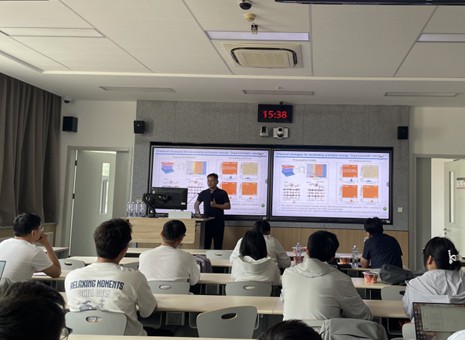
Professor Zhu then explained in detail how interface engineering not only mitigates degradation by passivating surface defects but also acts as a defensive layer against environmental degradation. He also dissects the underlying causes of PSC instability, examine the latest breakthroughs in interface modification techniques, and discuss the application of novel materials such as low-dimensional perovskites. The talk aims to illuminate the path forward in enhancing PSC durability, focusing on the integration of cutting-edge interface technologies and their potential to redefine the performance standards of perovskite photovoltaics. Finally, the professor had an exchange and discussion with the teachers and student and received a warm response from the teachers and students on the spot.
-
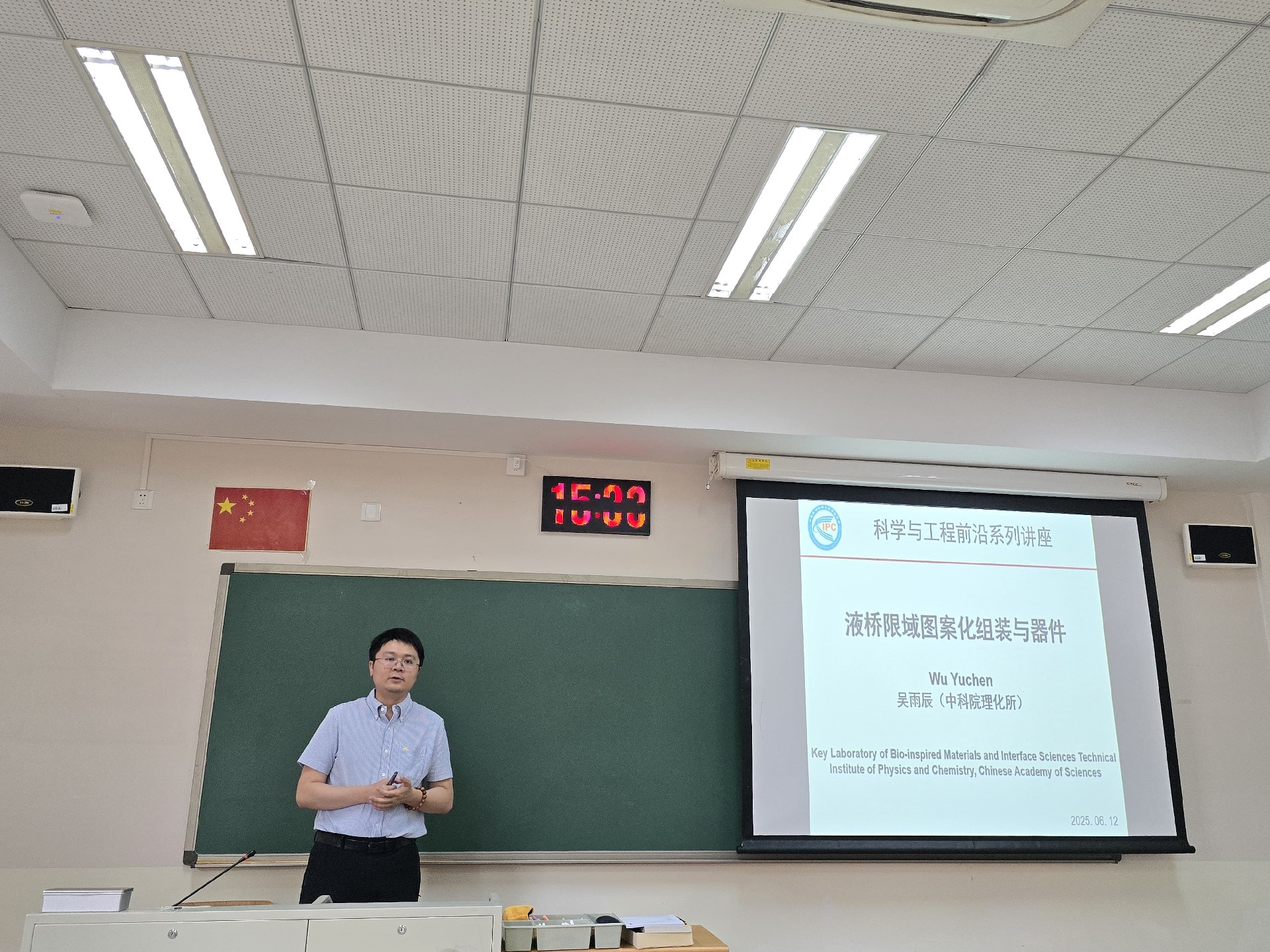 Dr. Yuchen Wu's Lecture on "Capillary Bridges-Confined Micro-Fabrication Techniques and Devices"
Dr. Yuchen Wu's Lecture on "Capillary Bridges-Confined Micro-Fabrication Techniques and Devices"At 3:30 p.m. on 12 June 2025, Dr Yuchen Wu of the Technical Institute of Physics and Chemistry, Chinese Academy of Sciences, delivered a compelling lecture entitled “Liquid-Bridge-Confined Micro-fabrication Techniques and Devices” in Room 362, Xueyuan 2, Yanqi Lake Campus. The event, hosted at the invitation of Professor Hui Huang as part of the “Frontiers in Materials Science and Engineering” lecture series, drew a large audience of faculty and students and fostered a vibrant academic atmosphere.
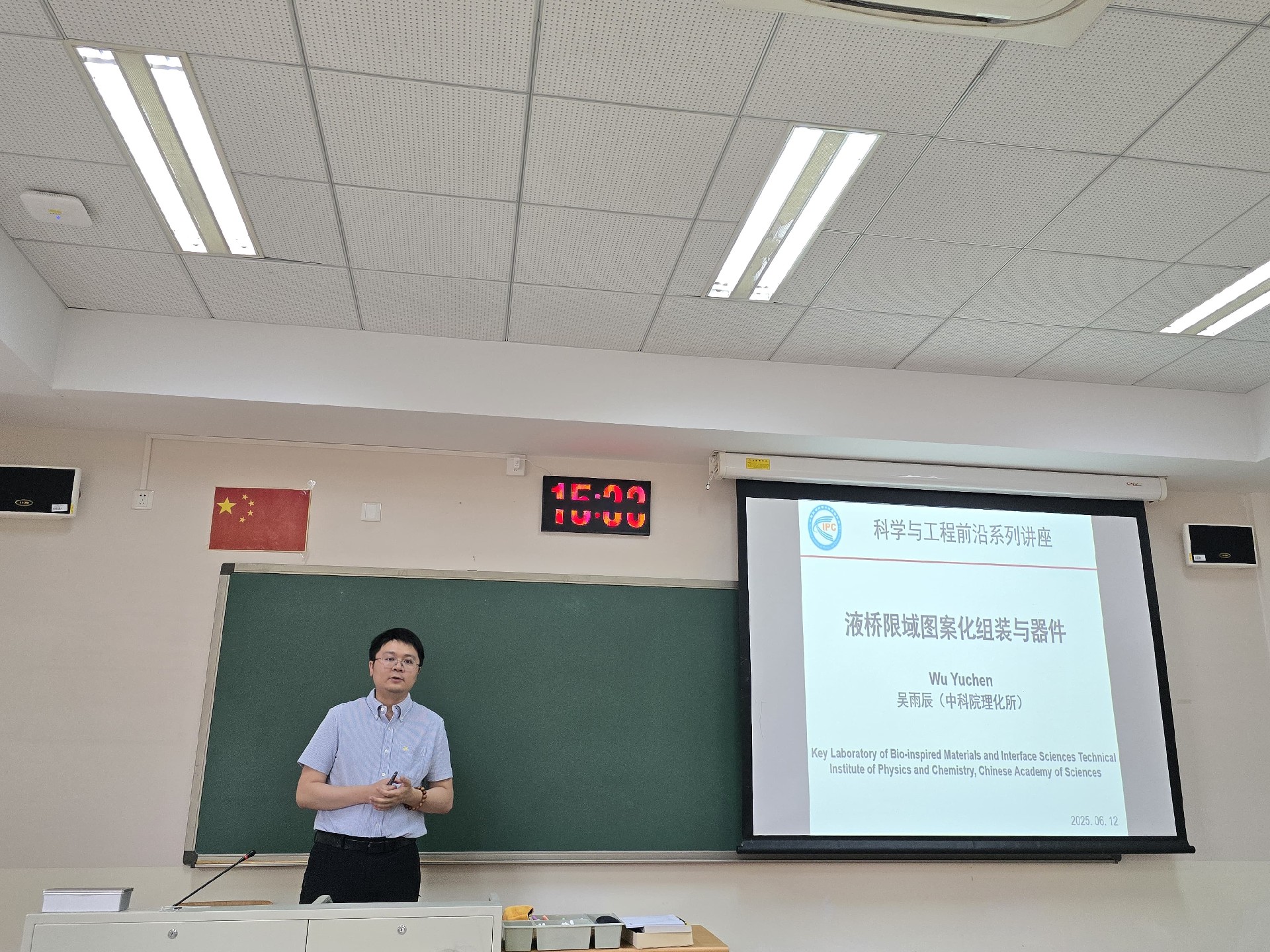
Dr Wu has long focused on liquid-phase micro-/nano-fabrication technologies and functional micro-/nano-devices. He has achieved a series of innovative results in interfacial confinement effects and liquid-bridge-confined assembly methods. To date, he has published 114 SCI-indexed papers in leading journals such as Nature Nanotechnology, Nature Electronics and Advanced Materials, garnering more than 10,000 citations, and has led over thirty projects funded by the National Natural Science Foundation of China and other agencies.

Opening his talk, Dr Wu reviewed global trends in advanced manufacturing and optoelectronic information technologies, highlighting the severe challenges traditional semiconductor micro-fabrication faces when integrating emerging nanomaterials. He then provided an in-depth explanation of the principles behind liquid-bridge-confined micro-fabrication, the pathways for constructing key devices and the prospects for applying the technique in high-performance optoelectronic device fabrication. By introducing concepts such as interfacial regulation and three-dimensional microscale topology control, he showcased his team’s original advances in three-dimensional flow manipulation and liquid-bridge evaporation templates, presenting new methods and solutions for highly integrated, high-precision micro-device manufacturing.
During the Q&A session, Dr Wu answered questions from the audience with patience and precision, sparking wide-ranging and in-depth academic discussions. Participants commented that the lecture broadened their research perspectives and provided valuable insights for future work in micro-/nano-fabrication and device integration.

-
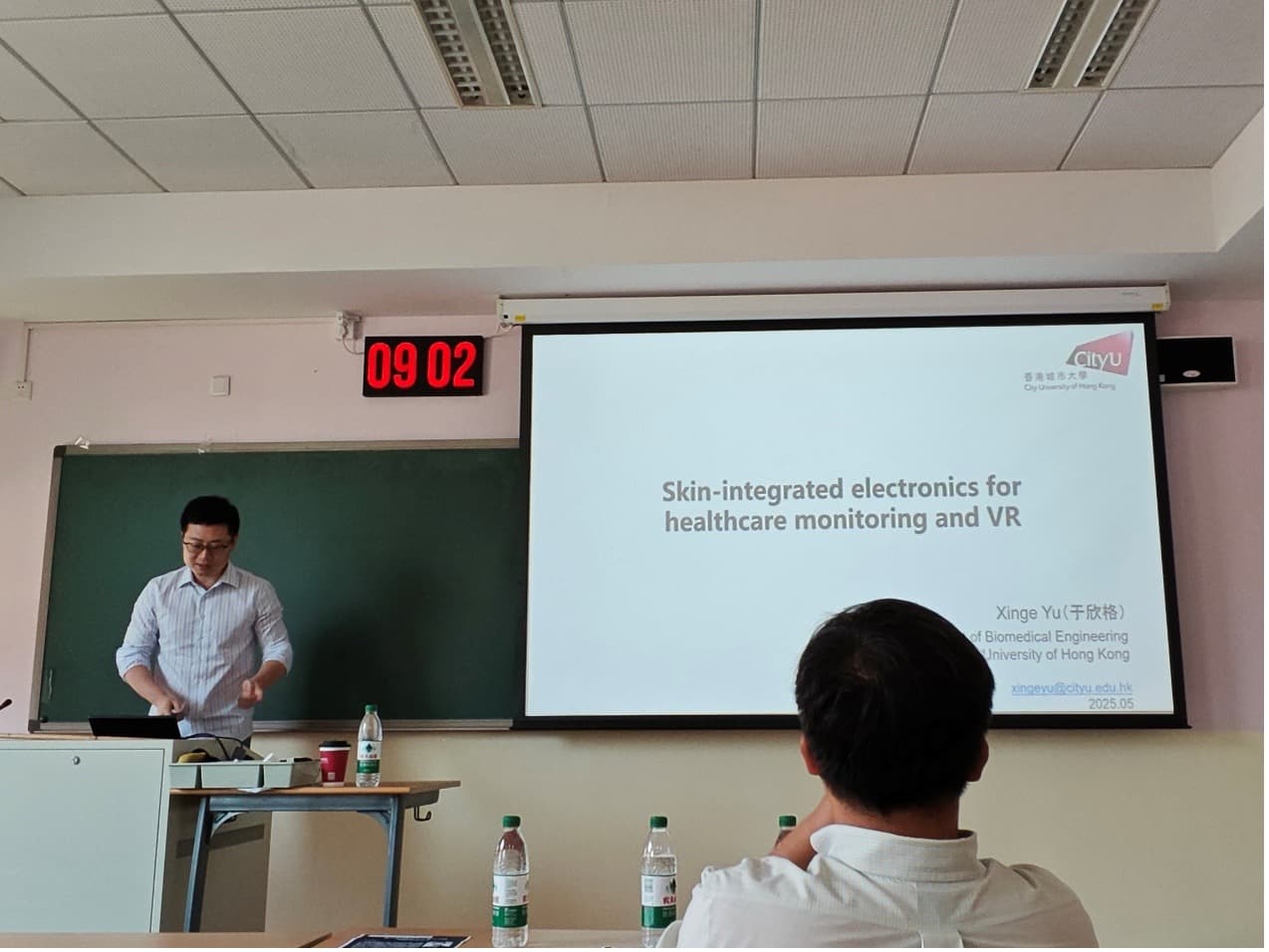 Professor Xinge Yu’s lecture on “Skin-integrated Electronics for Healthcare Monitoring and VR”
Professor Xinge Yu’s lecture on “Skin-integrated Electronics for Healthcare Monitoring and VR”At 9 a.m. on May 30, 2025, Professor Xinge Yu from the School of Digital Medicine of City University of Hong Kong, invited by Professor Hui Huang, held a lecture on the theme of “Skin-integrated Electronics for Healthcare Monitoring and VR” at Room 304, Second Academic Park, Yanqihu Campus, University of Chinese Academy of Sciences (UCAS).
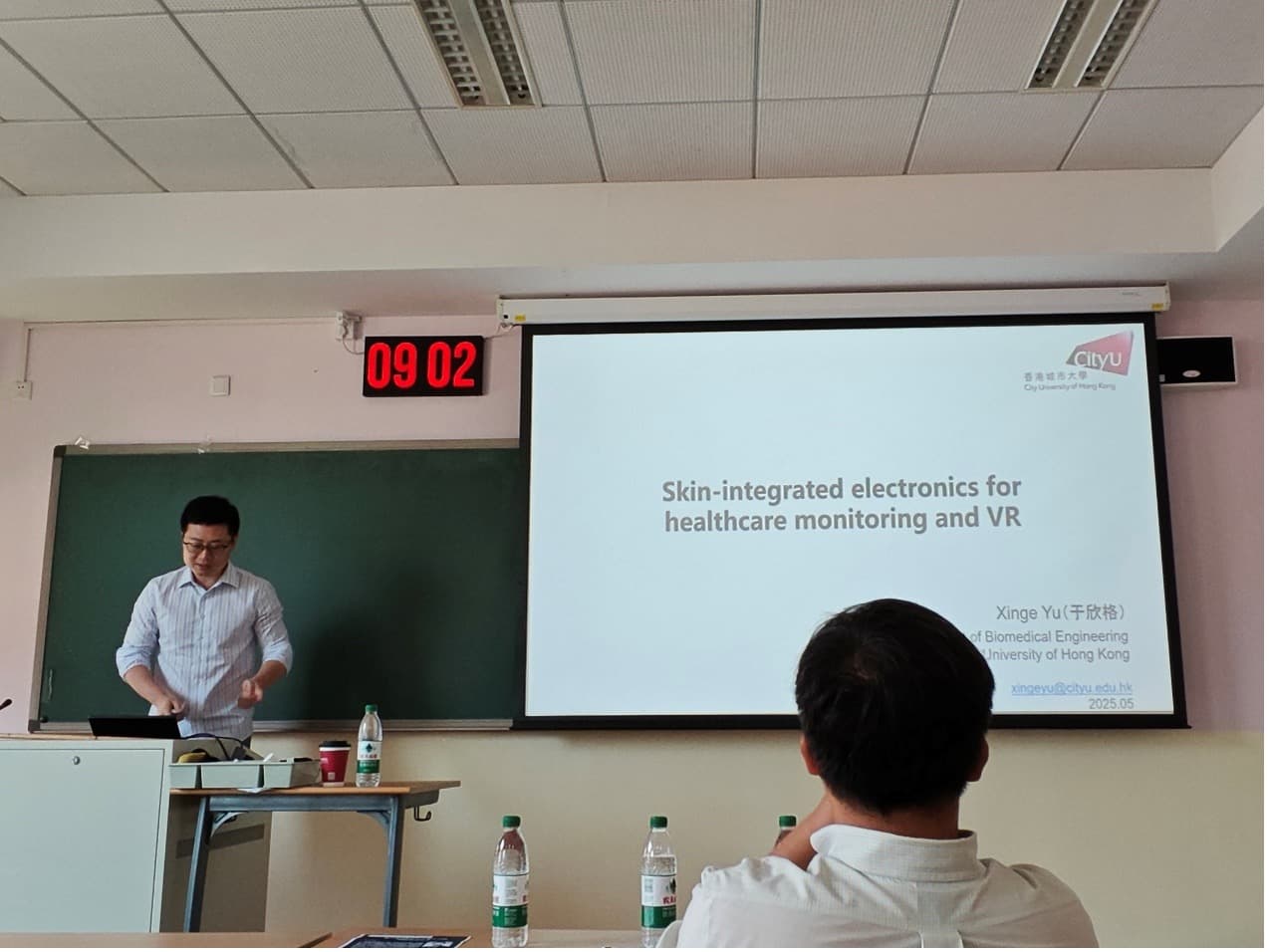
Professor Xinge Yu graduated from the Department of Optical Engineering at the University of Electronic Science and Technology of China in 2005 with a Bachelor's degree in Engineering; Graduated from the University of Electronic Science and Technology of China in 2015 with a doctoral degree. Professor Xinge Yu is a member of the Hong Kong Academy of Youth Sciences, Vice Dean of the School of Digital Medicine at City University of Hong Kong, and Deputy Director of the Hong Kong Cardiovascular Health Engineering Research Center. In 2023, he was awarded the Hong Kong RGC Research Fellow, Outstanding Youth Science Foundation (Hong Kong and Macau), MIT Technology Review Innovation 35, IEEE Nanomedicine Inventor, MINE Young Scientist, and the Geneva International Invention Exhibition Gold Award. His research direction is the application of new flexible electronics in the field of biomedicine and intelligent tactile VR. Currently serving as the deputy editor in chief and editorial board member for multiple journals of Science Advances. Professor Xinge Yu has been recognized as one of the top 2% highly cited scholars at Stanford University. He has published over 200 papers in journals such as Nature, Nature Materials, Nature Biomedical Engineering, Nature Machine Intelligence, Nature Electronics, Nature Communications, and Science Advances, and has applied for/been granted over 50 US patents.
Professor Xinge Yu first pointed out that the development of perception and interaction technologies based on flexible electronics and the human body is of great significance in many fields such as biomedicine, health, and sensing. Therefore, this is also a top priority in the research of flexible electronics technology. At present, the global research focus is almost entirely on the sensing technology of flexible electronics, while the research on information feedback of flexible electronics is relatively scarce. One of the main reasons is that flexible information feedback technology relies on actuators that are larger in size, weight, and power consumption compared to sensor devices. However, information feedback technology is an indispensable part of the interaction and perception of flexible electronics. For example, flexible electronics can collect changes in healthy physiological signals by wearing them on the human body. At the same time, by sampling and processing the collected health signals, the wearer's health status and potential diseases can be analyzed in a timely manner, and the user can be informed in a timely manner through feedback methods such as sound and pressure.

Next, Professor Xinge Yu used monitoring heart rate as an example to talk about their team's development of a wearable flexible electronic device with extremely high moisture wicking efficiency. This device is lightweight, scalable, and significantly improves sweat wicking efficiency, solving the most critical problem faced by wearable biomedical devices. It can provide reliable and stable vital sign monitoring for up to a week without discomfort or signal distortion/interruption caused by sweating. In addition, Professor Xinge Yu’s team has also integrated wearable devices with the VR field, developing three multimodal tactile feedback interfaces with temperature, mechanical deformation, and electrical tactile stimulation. This wearable multimodal tactile feedback interface provides users with multi-dimensional high fidelity information, improves the immersion of virtual reality and augmented reality systems, and allows users to participate in the virtual world more immersively.
At the end of the lecture, Professor Xinge Yu and everyone discussed profound issues such as how to achieve power supply for wearable devices, how to process and transmit large amounts of collected data, and what process should be adopted to prepare patterned electrodes. The lecture sparked lively discussions among teachers and classmates. Professor Xinge Yu’s lecture not only deepened the understanding of the interaction and perception of new flexible electronics among the attending teachers and students, but also provided valuable guidance for researchers.
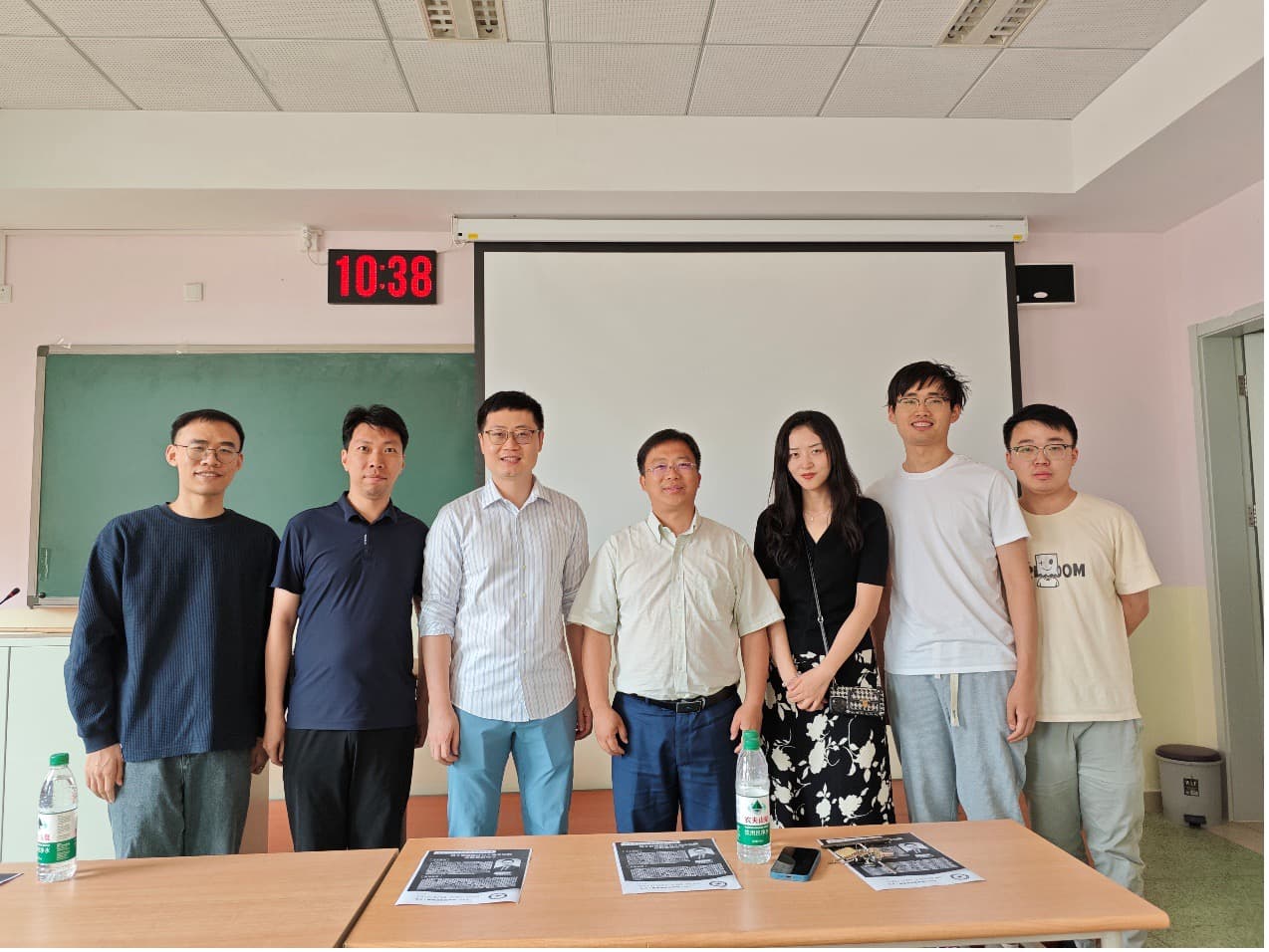
-
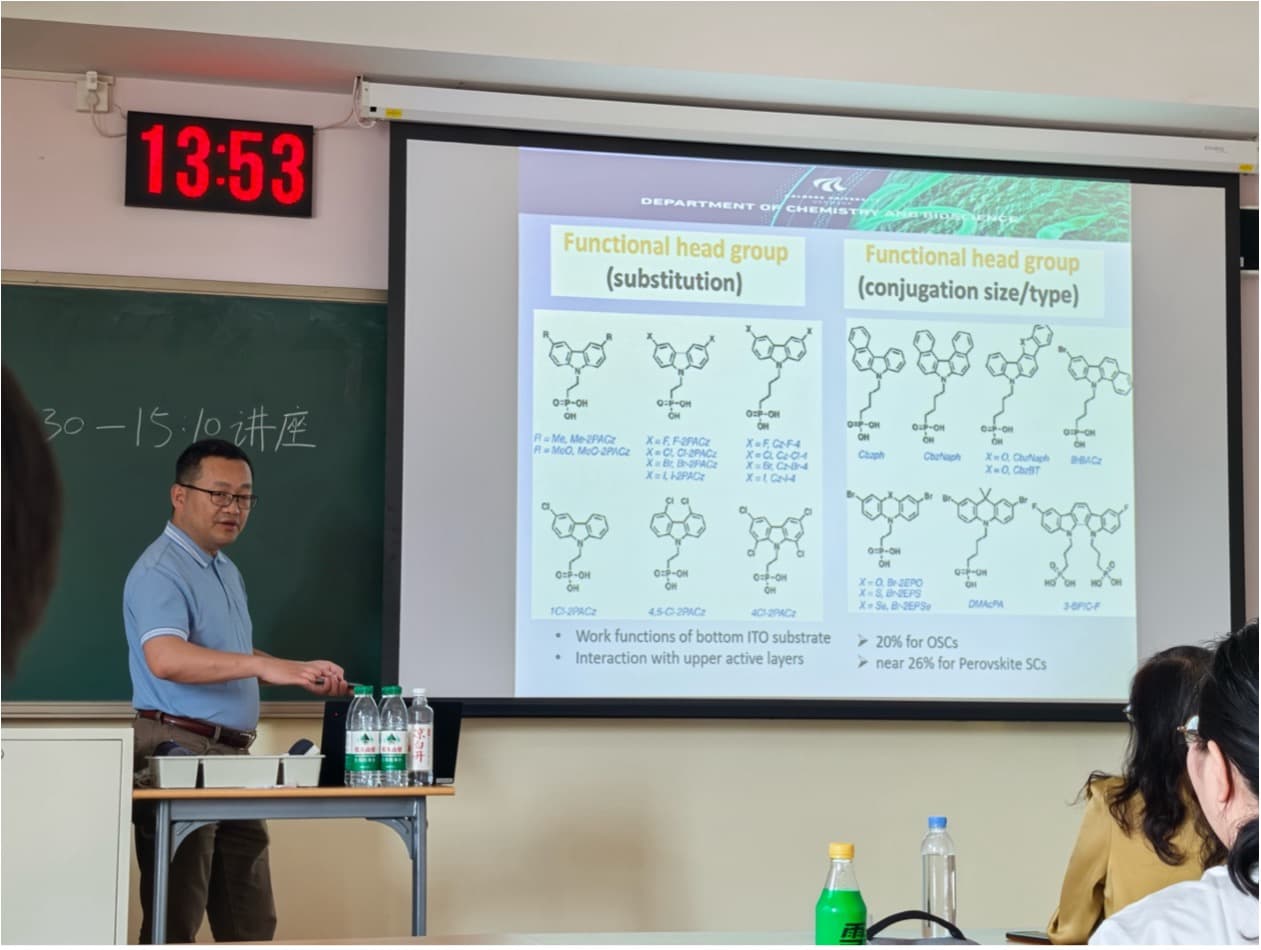 Lecture by Dr. Donghong Yu on “Novel Carbazole-Based Self-Assembled Monolayers: Molecular Conformation and Its Impact on Organic Photovoltaic Performance”
Lecture by Dr. Donghong Yu on “Novel Carbazole-Based Self-Assembled Monolayers: Molecular Conformation and Its Impact on Organic Photovoltaic Performance”At 1:30 PM on May 26, 2025, Dr. Donghong Yu from the Department of Chemistry and Bioscience at Aalborg University, Denmark, delivered a lecture titled “Novel Carbazole-Based Self-Assembled Monolayers: Molecular Conformation and Its Impact on Organic Photovoltaic Performance” at Room 304, Teaching Building No. 2, Yanqi Lake Campus, University of Chinese Academy of Sciences. The lecture was hosted at the invitation of Professor Hui Huang from the School of Materials Science and Optoelectronic Technology.
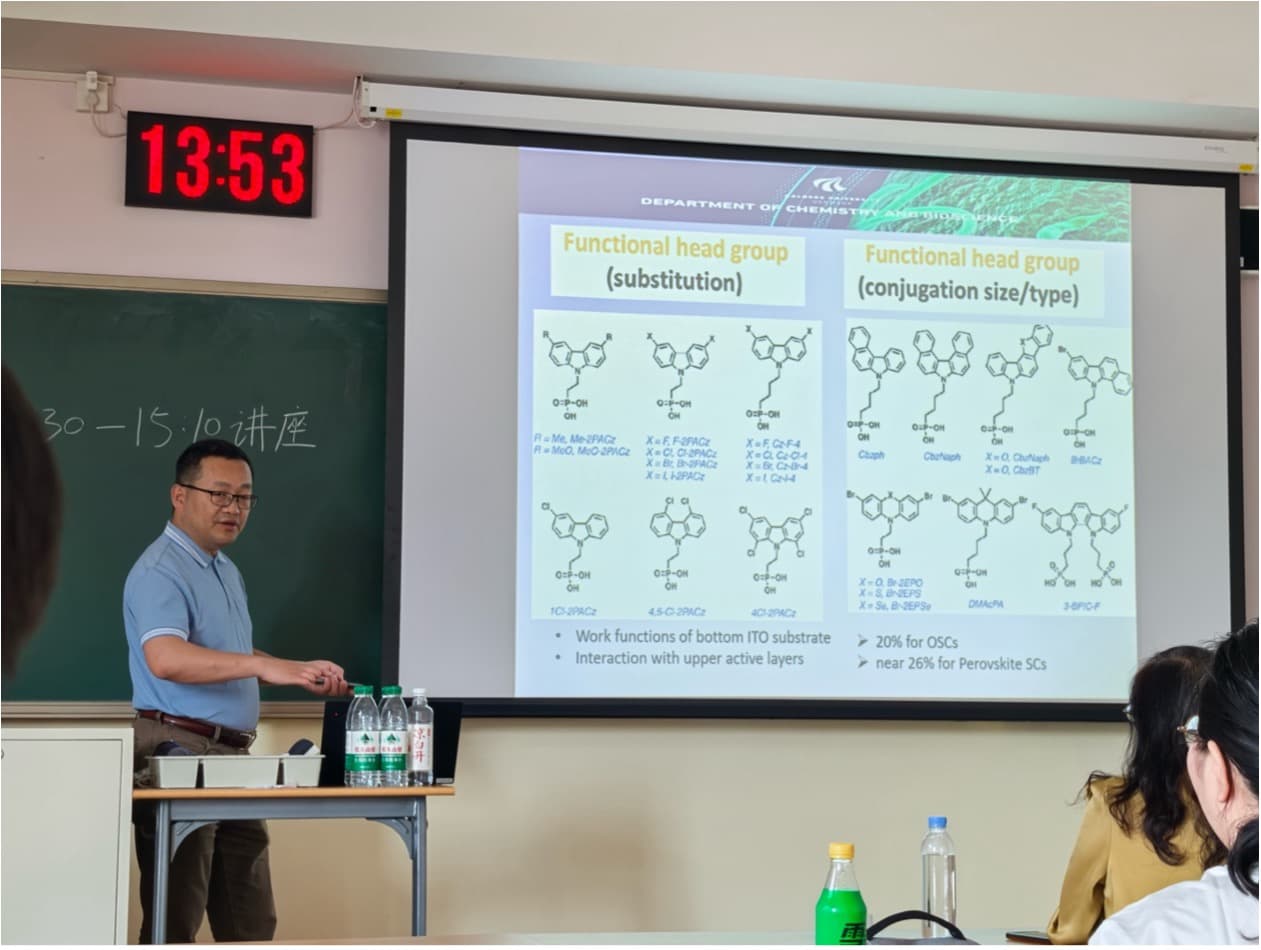
Dr. Donghong Yu received his Bachelor’s and Master’s degrees in Chemistry from Jilin University in 1991 and 1994, respectively. In 1997, he earned his Ph.D. from the State Key Laboratory of Polymer Chemistry and Physics at the Changchun Institute of Applied Chemistry, Chinese Academy of Sciences. From 1997 to 2006, he held positions as Assistant Professor, Special Research Fellow, Research Assistant Professor, and Assistant Professor at the State Key Laboratory of Polymer Chemistry and Physics (Changchun Institute of Applied Chemistry, CAS), the National Institute for Materials and Chemical Research (AIST, Japan), and the Departments of Mechanical Engineering and Chemistry & Bioscience at Aalborg University, Denmark. Since 2006, he has been a tenured Associate Professor in the Department of Chemistry and Bioscience at Aalborg University.
Dr. Yu’s research interests span organic photovoltaic materials, polymer light-emitting diodes, molecularly imprinted polymers (for molecular recognition and biosensing), and inorganic-organic hybrid nanobiomaterials. He has led projects funded by the Danish Agency for Technology and Innovation, the Danish National Science Foundation, and the Danish Strategic Research Council, with a total research funding exceeding DKK 20 million. He has published 152 academic papers with over 4,030 citations. He has supervised 5 postdoctoral researchers, 12 Ph.D. students, and co-supervised 5 Ph.D. candidates. In 2009, he was honored with the Best Teacher Award at Aalborg University.
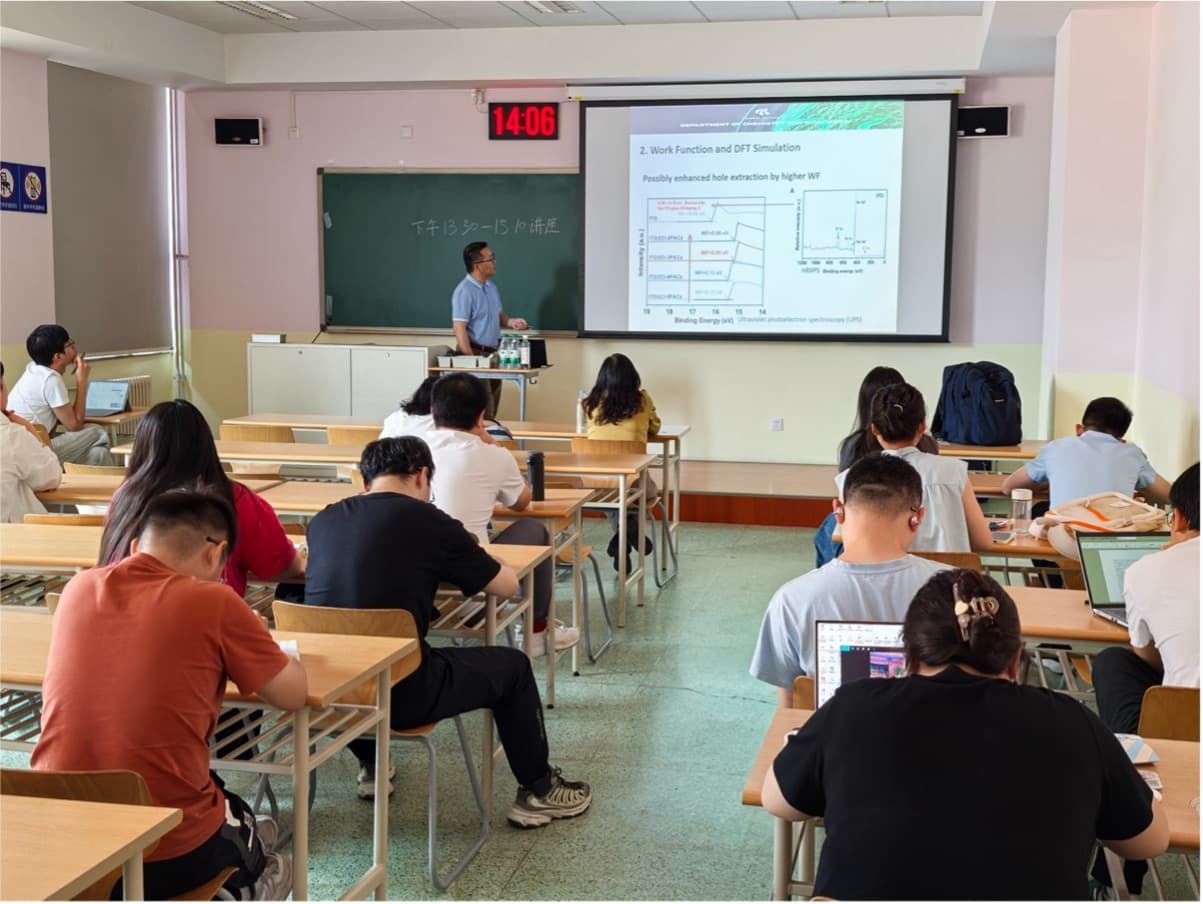
In this lecture, Dr. Donghong Yu focused on a highly promising class of materials—carbazole-based self-assembled monolayers (SAMs)—and explored their application as hole transport layers (HTLs) in organic solar cells. Owing to their ultrathin film-forming capability and excellent interfacial tuning properties, these SAM materials have emerged as promising candidates for enhancing the architecture of photovoltaic devices, significantly enhancing both stability and efficiency. However, the specific influence of alkyl spacer chain length on the self-assembly behavior and device performance of SAMs remains insufficiently understood. To address this, Dr. Yu’s team designed and synthesized four bis(diazole)-substituted SAM materials with varying alkyl spacer lengths. A systematic evaluation was carried out to compare their molecular ordering, surface coverage, and impact on device performance.
Structural analyses, including single-crystal X-ray diffraction, revealed that SAMs with shorter spacer chains exhibited stronger intermolecular interactions and denser packing. This favorable molecular conformation promoted the formation of more ordered monolayers and significantly influenced the molecular footprint and surface coverage on ITO electrodes. As a result, hole injection efficiency and interfacial charge transport were substantially improved. Thanks to these structural optimizations, the SAM-based devices ultimately achieved a power conversion efficiency exceeding 18%, positioning them at the forefront of current SAM-based organic photovoltaic technologies.
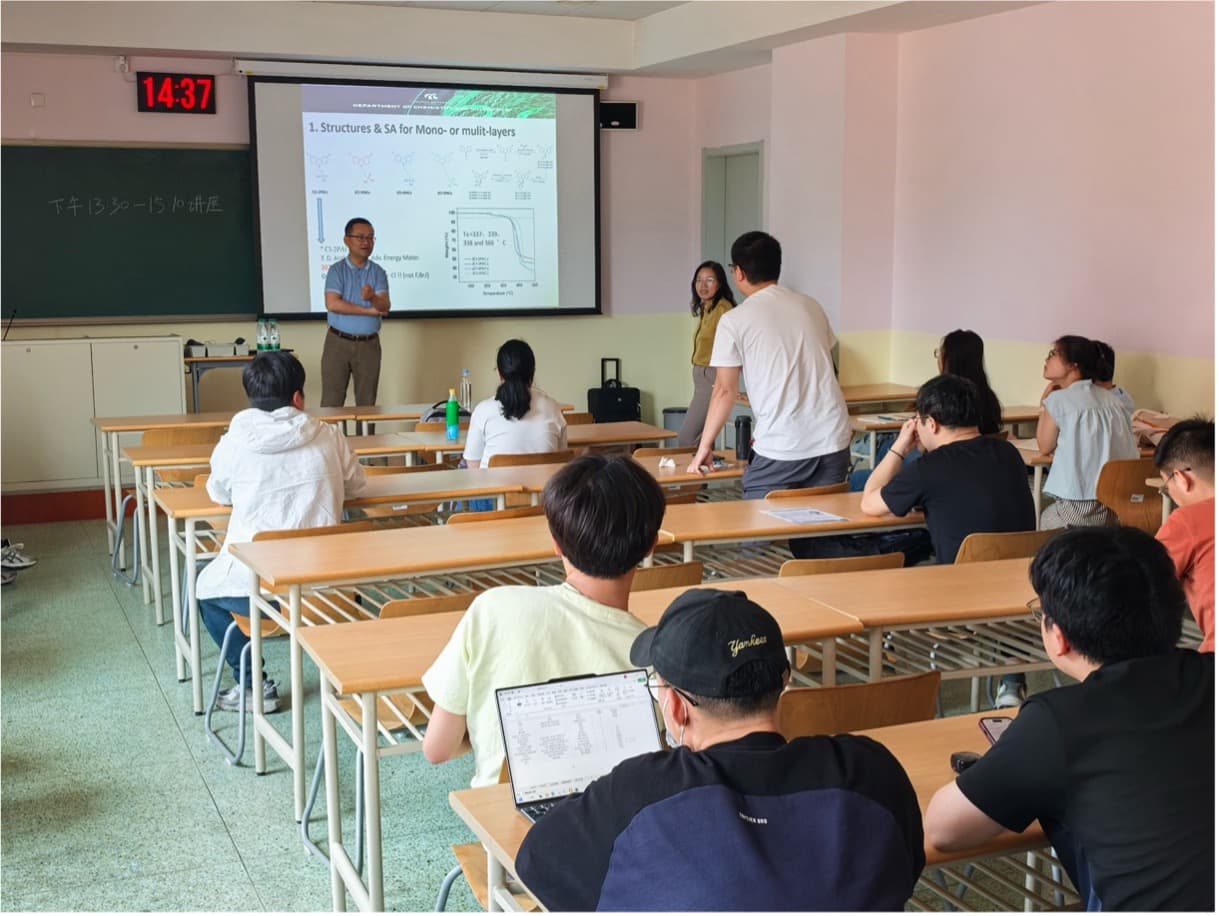
This research provides new insights into the correlation between molecular structure and device performance in organic electronics. It also offers critical guidance for the molecular design of hole transport layers in next-generation, high-efficiency photovoltaic devices. At the conclusion of the lecture, Dr. Yu engaged in thorough discussions with faculty and students on topics such as material synthesis strategies and interfacial physics, thereby deepening the participants’ understanding of these advanced SAM-based materials.
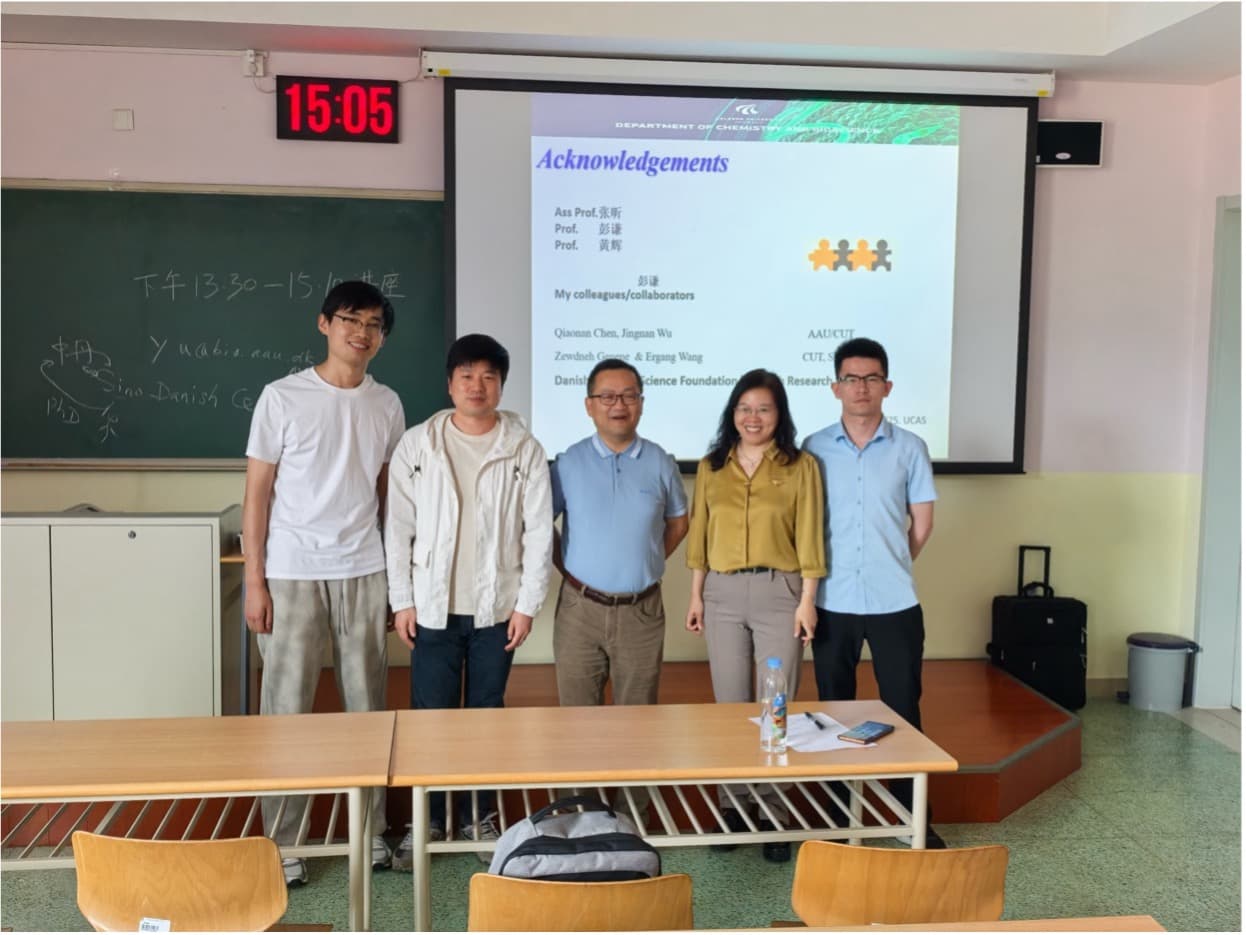
-
 Dr. Li Yan's lecture on the topic of "Publishing in Cell Press Physical Science Journals"
Dr. Li Yan's lecture on the topic of "Publishing in Cell Press Physical Science Journals"On December 23, 2024, at 2:00 PM, Dr. Li Yan from Cell Press was invited by Professor Huang Hui to give a lecture on the topic "Publishing in Cell Press Physical Science Journals" at the University of Chinese Academy of Sciences. The lecture took place in Room 305 of Teaching Building 1.
Dr. Li Yan is a scientific editor at Cell Press, currently working for Matter, a flagship journal in materials science, and Cell Reports Physical Science, an open-access journal in physical science. He graduated with a bachelor's degree from Tianjin University and obtained his Ph.D. from the Department of Chemistry at Tsinghua University. He has also conducted postdoctoral research at the University of Houston and Wageningen University. Before joining Cell Press, Dr. Li worked as a journal editor at Wiley Publishing for several years.

The lecture began with an introduction to the founding and development of Cell Press, followed by an overview of the major journals published by Cell Press, including Cell, Chem, Joule, Matter, Cell Reports Physical Science, and Device. Special emphasis was placed on Matter, a flagship journal in materials science, and Cell Reports Physical Science, an open-access journal that has gained widespread attention and recognition. This helped the audience better understand the unique characteristics of each of the publisher's journals.
Next, Dr. Li outlined the structure of a research paper and provided specific guidance on what content should be included in each section. Through a Q&A format, Dr. Li effectively addressed common challenges in ensuring that the content of a paper aligns with its theme.

Dr. Li also gave two counterexamples to illustrate how to correctly and effectively use paper titles and figures to present research results to the readers. Additionally, Dr. Li shared his views on current trends such as the use of AI for paper editing and appealed to the audience to use generative AI tools correctly and responsibly to assist with paper writing. He provided practical methods that would be helpful for writing and editing papers in the future.
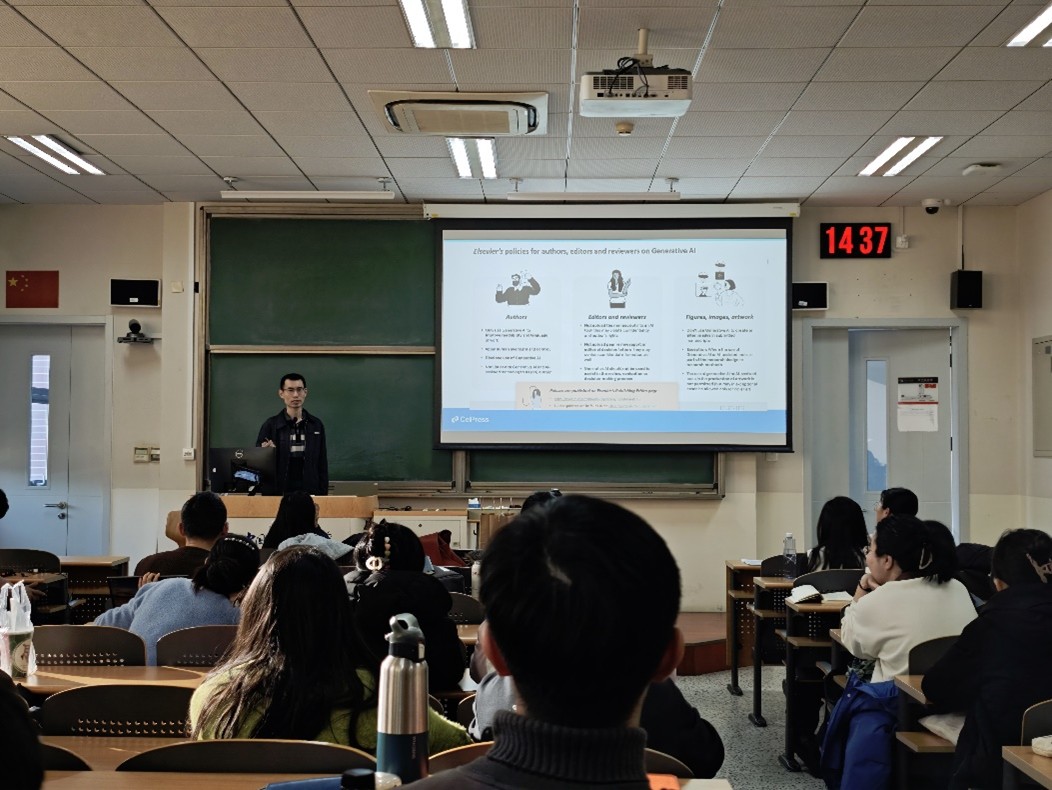
Finally, Dr. Li discussed important principles for responding to reviewer comments after manuscript submission and summarized key issues to consider during the submission process. This sparked a lively discussion among the faculty and students.
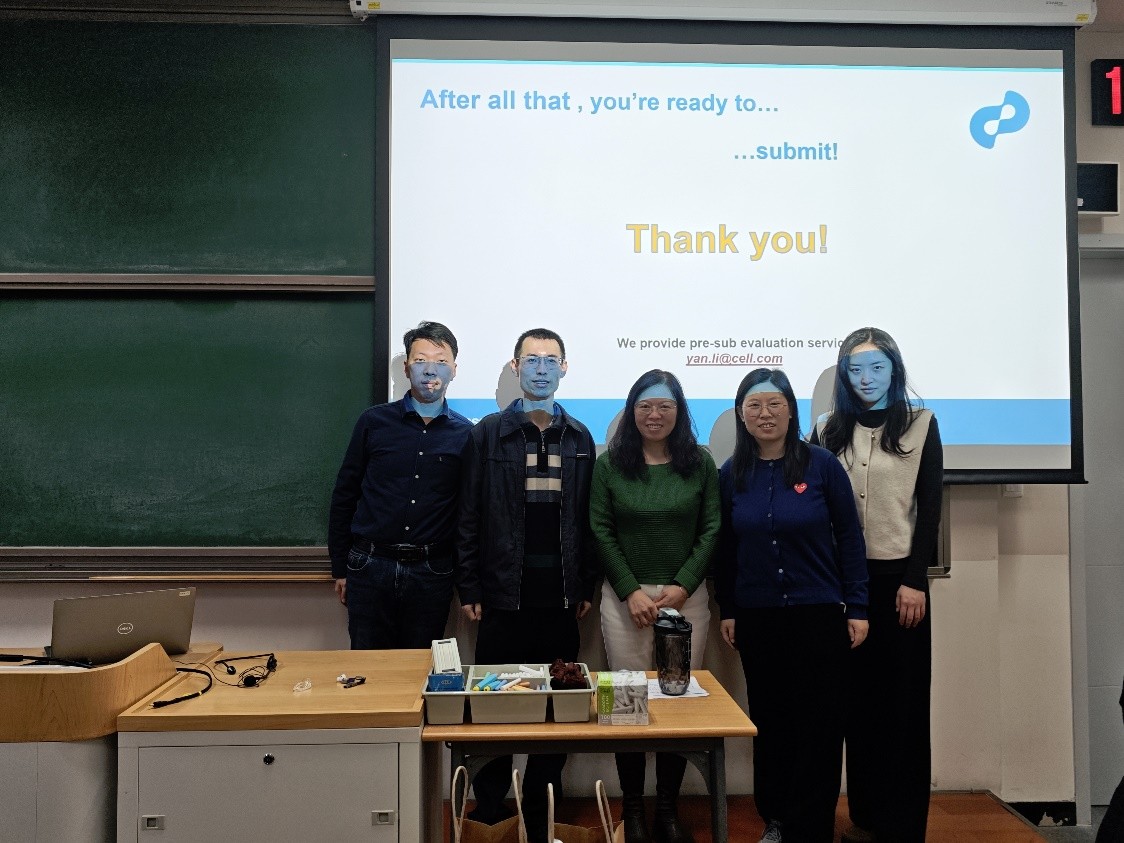
-
 Dr. Liao Kuangbiao's lecture on "Artificial Intelligence in Synthetic Chemistry"
Dr. Liao Kuangbiao's lecture on "Artificial Intelligence in Synthetic Chemistry"On the morning of December 12, 2024, at 10:30 AM, Dr. Liao Kuangbiao, a researcher from the Guangzhou National Laboratory, was invited by Professor Huang Hui to give a lecture on "Artificial Intelligence in Synthetic Chemistry" at the University of Chinese Academy of Sciences. The lecture was held in Room 305 of Teaching Building 1.
Dr. Liao Kuangbiao is a researcher at the Guangzhou National Laboratory, Chief Scientist at AIChemEco, a member of the National Youth Federation, and a standing committee member of the Guangzhou Association for Science and Technology. He has received several prestigious honors, including the Guangdong Youth May Fourth Medal, National High-level Overseas Young Talent, Outstanding Expert in Guangzhou, and the Most Beautiful Scientific Worker in Guangzhou. He graduated with a bachelor's degree from Sun Yat-sen University in 2013 and earned his PhD from Emory University in the United States in 2017. In 2018, he joined AbbVie Pharmaceuticals, and in 2019, he returned to China to work as a researcher at the Bioland Lab, where he was responsible for establishing the chemical synthesis platform. In 2021, he became a researcher at the Guangzhou National Laboratory and founded AIChemEco, where he currently serves as Chief Scientist. His research interest is in AI chemistry. He has long been committed to designing and building the next generation of automated high-throughput synthesis platforms, developing chemical reaction big data systems, advancing AI models for reaction prediction, and creating new organic synthesis methodologies. Up to now, he has published a series of academic papers as the corresponding or first author in top journals such as Nature (2 papers), Nature Chemistry, Chem, and ACIE.
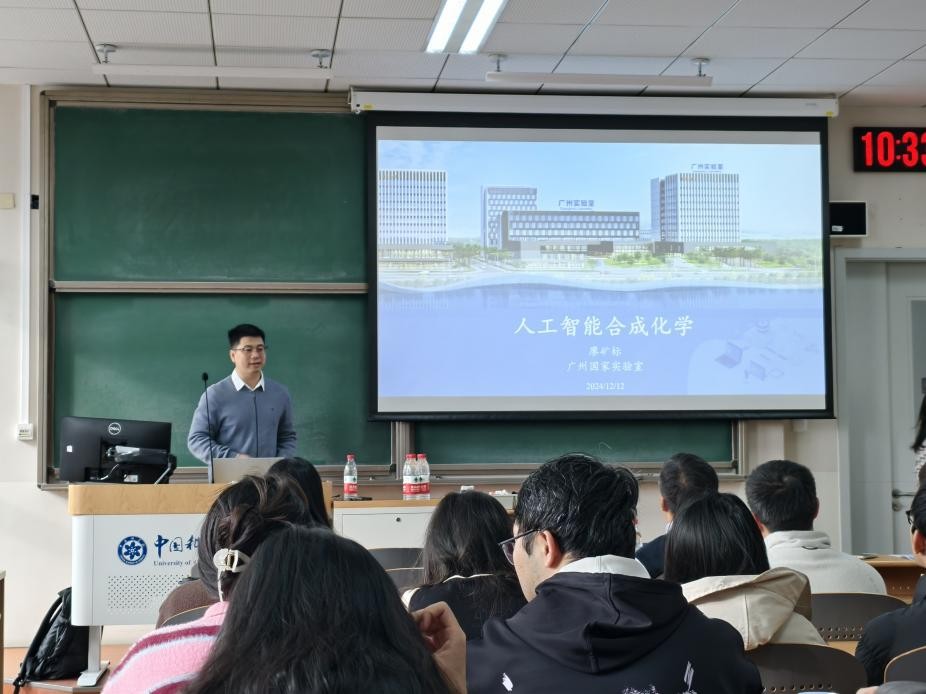
Before the lecture began, Dr. Liao posed an interesting question: "Why did 'AI-driven protein structure prediction' win the Nobel Prize in Chemistry?" This sparked strong interest in AI among the faculty and students. He then provided a detailed overview of the existing challenges in the field of synthetic chemistry, and based on these issues, innovatively proposed the use of AI to assist in chemical research.
The Fourth Industrial Revolution has propelled the development of synthetic chemistry by seamlessly integrating cutting-edge technologies such as automation, data science, and AI. Dr. Liao’s research team has been dedicated to advancing AI chemistry and contributing to the paradigm shift in synthetic chemistry research. The lecture detailed how his team has addressed challenges related to high-throughput automation, standardized data, and AI accessibility. It also discussed how they have evolved from the automation-based synthesis stage to an AI-driven intelligent synthesis stage, applying these innovations in the discovery and optimization of new reactions.

The lecture also introduced a large language model platform for synthetic chemistry called "SynAsk" and provided a detailed comparison of this AI platform with ChatGPT-4o in synthetic chemistry research, demonstrating how SynAsk outperforms ChatGPT in this field. In addition, the lecture showed how SynAsk can be used to effectively predict the chiral ligands and the yield of synthetic reactions, showing the immense potential of AI in synthetic chemistry.

Finally, the lecture provided a thorough introduction to AI model training and dimensionality reduction techniques and gave a forward-looking perspective on the future of AI-driven chemistry, sparking a lively discussion among faculty and students.

-
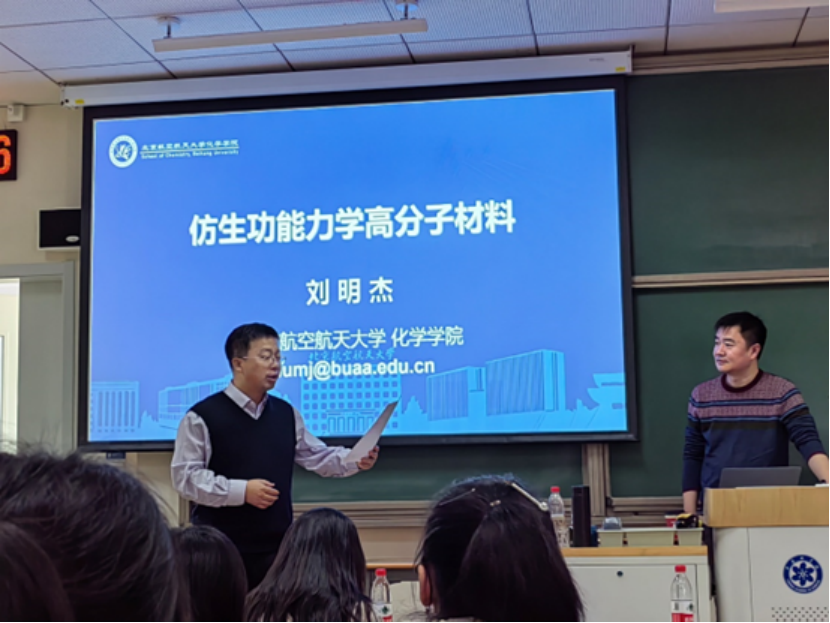 Lecture by Professor Mingjie Liu on “Biomimetic Functional Mechanics Polymer Materials”
Lecture by Professor Mingjie Liu on “Biomimetic Functional Mechanics Polymer Materials”At 14:00 p.m. on December 3, 2024, Professor Mingjie Liu from the School of Chemistry of Beijing University of Aeronautics and Astronautics, invited by Professor Huang Hui from the School of Materials Science and Optoelectronics Technology, held a lecture on the theme of " Biomimetic Functional Mechanics Polymer Materials " at Room 404, Building 1, Yanqihu Campus, University of Chinese Academy of Sciences (UCAS).

Professor Mingjie Liu graduated from the Department of Applied Chemistry at Beijing University of Chemical Technology in 2005 with a Bachelor of Science degree; In 2010, he graduated from the National Nanoscience Center of the Chinese Academy of Sciences with a doctor's degree in science. Professor Mingjie Liu is a Changjiang Scholar Distinguished Professor, recipient of the National Science Foundation for Distinguished Young Scholars, Chief Scientist of the National Key Research and Development Program, and currently serves as the Dean of the School of Chemistry at Beihang University. He is mainly committed to the design, preparation and application research of biomimetic functional mechanics polymer composites. He has published 120 papers in journals such as Nature, Nat. Rev. Mater., Nat. Commun., Sci. Adv., Angew., Adv. Mater., JACS, etc.
Professor Mingjie Liu first pointed out that polymer composite materials have been widely used in aviation, automotive, and green power generation fields due to their strong designability, excellent performance, and diverse functions. However, harsh environments such as lightweight, multifunctionality, high speed, and high temperature require higher performance and functionality of polymer composite materials. In the future composite system, it is necessary to establish an optimization model that links functional elements with macroscopic properties for multiphase composite, which is the key to improving material mechanical properties and expanding functionality. In addition, the polymer confinement effect in composite systems has a significant impact on the macroscopic performance control and optimization of materials, and it is necessary to understand the confinement effect from a molecular theoretical perspective.
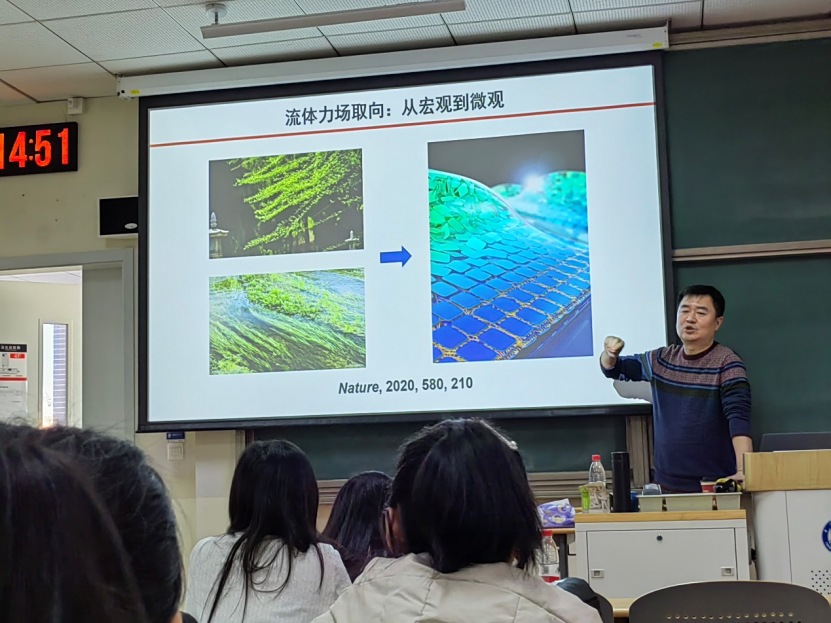
Next, Professor Mingjie Liu used biomimetic materials as an example to explain how to achieve the integration of structure and function of biomaterials through the design of multiphase confinement composites and multi-level ordered structures. Mingjie Liu's research group used confined space to regulate molecular movement, and realized the independent movement of orthogonal networks in confined space, thus preparing orthogonal network oil-water gel, which successfully simulated various functions of muscles; Inspired by the fluid force field, the team utilized a super spreading shear fluid to regulate the layer by layer orientation of nanosheets, ensuring that the materials could be quickly assembled to form highly ordered structures, thus preparing high-strength and tough layered nanocomposites, simulating the lightweight and impact resistance characteristics of shells.
At the end of the lecture, Professor Mingjie Liu discussed with everyone whether hydrogels can replace human tissues, the material forming process and the application prospect of hydrogels in the field of optoelectronics. The lecture caused heated discussions among teachers and students. Professor Mingjie Liu's lecture not only deepened the understanding of biomimetic functional polymer materials among the attending teachers and students, but also provided valuable guidance for researchers.
